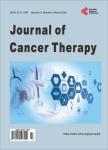A Phase II Trial of Preoperative Chemoradiotherapy with Oral DPD-Inhibitory Fluoropyrimidines in Patients with Advanced Rectal Cancer
A Phase II Trial of Preoperative Chemoradiotherapy with Oral DPD-Inhibitory Fluoropyrimidines in Patients with Advanced Rectal Cancer作者机构:Department of Surgery Kochi Health Sciences Center Kochi Japan Department of Surgery National Hospital Organization Kochi National Hospital Kochi Japan Department of Surgery Shikoku Central Hospital Ehime Japan Department of Surgery Takamatsu City Hospital Takamatsu Japan Department of Surgery Tokushima Municipal Hospital Tokushima Japan Department of Surgery Tokushima Prefectural Central Hospital Tokushima Japan Department of Surgery Tokushima Red Cross Hospital Tokushima Japan Department of Surgery Tokushima University Hospital Tokushima Japan
出 版 物:《Journal of Cancer Therapy》 (癌症治疗(英文))
年 卷 期:2012年第3卷第6期
页 面:989-995页
学科分类:1002[医学-临床医学] 100214[医学-肿瘤学] 10[医学]
主 题:S-1 UFT Chemoradiation Rectal Cancer
摘 要:Background: Preoperative chemoradiotherapy (CRT) with 5-FU has been widely used to improve local control of disease and to preserve anal sphincter in the treatment of rectal cancer. UFT and S-1 as oral dihydropyrimidine dehydrogenase (DPD)-inhibitory fluoropyrimidines enhance the therapeutic effect of 5-FU by modulating its metabolic pathways. The purpose of this study was to evaluate the efficacy and toxicity of CRT using UFT versus S-1 in patients with locally advanced rectal cancer. Methods: Fifty-nine patients who received preoperative CRT (40 Gy radiotherapy) were randomly assigned to either UFT or S-1 groups. UFT and S-1 were administered during the radiotherapy course. Response to CRT was determined using a histopathologic examination and RECIST of surgically resected specimens and classified as responders (CR, PR and grade 2, 3) or nonresponders (SD, PD and grade 0, 1). Results: All patients were randomly allocated to S-1 group (n = 30) or UFT group (n = 29). Pathological response rate (Grade2 and Grade3) was 57% in the S-1 group and 45% in the UFT group (p = 0.36). Pathological complete response (CR) rate (Grade3) was 7% in the S-1 group and 4% in the UFT group (p = 0.98). There was no statistically significant difference between the two groups in regard to the response rate of RECIST (p = 0.52). There was no statistically significant difference between the groups based on the downstaging rate, resection of tumor, sphincter preservation and marginal invasion. The incidence of Grade 3 diarrhea was significantly more frequent in the S-1 group (7%) compared with the UFT group (0%) (p = 0.02). Conclusion: The results supported the conclusion that CRT using UFT or S-1 is effective and feasible for patients with locally advanced rectal cancer.



